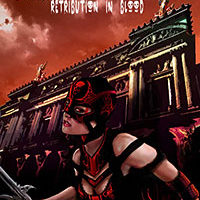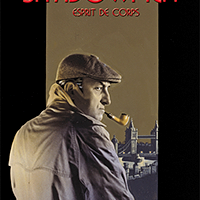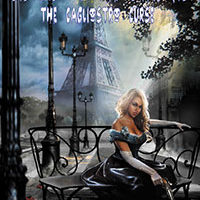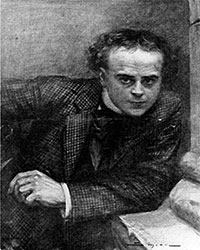
Phantom of the Opera. Most people have heard of that work, most likely due to the play or various movie versions. But most are probably not aware of its author, Gaston Leroux. Or his other works, including Rouletabille, a dashing young journalist who solved mysteries by use of pure deductive reasoning, what he calls the “good end of reason.”
“Rouletabille” is the nickname for the 18-year-old journalist Joséph Joséphin, who was raised in an orphanage. From a note in the first story, we learn that “Rouletabille” is French for “shooting your marble into the ring,” and may refer to the character rushing around. From 1907-22, Leroux wrote seven Rouletabille novels (two more authorized novels were written by another). Black Coat Press has made available two of them, but will probably not do additional ones. But both works are pretty important. One is considered a classic “locked room” mystery, and the other is considered one of the first secret agent novels.
In the first, Rouletabille and the Mystery of the Yellow Room introduces the hero. The story is obviously written in the style of Sherlock Holmes. The story is presented by the narrator, one Maitre Sainclair, a lawyer friend of Rouletabille, as something that happened several years prior, because the case was so well know. The narrator also includes notes from others involved in the case. Sainclair is present for the whole story, much like Watson, but seems to take less involvement than Watson. Does he narrate the other works?
The case starts when the victim, Mathilde Stangerson, the “Lady in Black,” is attacked in a locked room known as the “Yellow Room.” There is only one window, barred and impossible to get through. There is only one door, which she had locked and bolted after entering to sleep. Her father, the scientist Professor Stangerson, along with an associate are forced to break down the door when they hear gunshots, and find Mathilde unconscious and the room in disarray, along with a bloody handprint on the wall. But no one else!
Because of the fame of the Professor and the mystery of the Yellow Room, this becomes a major case, with French Surete detective Frederick Larsan on the case.
The mystery of who is the attacker is and who might have assisted him causes several to be accused, including Professor Robert Darzac, Mathilde’s fiance. This is due to several people associated with the case acting suspiciously, and a later incident when Mathilde is stabbed and another killed.
But Rouletabille is able to work out the cause of all this.
Several years prior, the Stangerson’s were living in America. While there, Mathilde was romanced by a Frenchman, Jean Rossel. They eloped, and had a child (who was put in an orphanage). But it was revealed that Rossel was an international criminal named Ballmeyer, described as a “gentleman thief” (though he doesn’t seem much like Arsene Lupin and others, as they don’t kill or attack others, and he seems willing to do so).
But when Mathilde announced her impending marriage to Darzac, Ballmeyer re-emerged to threaten them, as he still loved Mathilde. He was who had attacked her in the Yellow Room. And he was really Larsan, so was in a position to impede the investigation and turn suspicion on others. But Rouletabille figures it all out.
Oh, and the answer to the mystery of the Yellow Room? You’ll have to read the story.
In the second Rouletabille novel, The Scent of the Lady in Black, set a couple of years later, Rouletabille comes to her assistance again, and also confronts Ballmeyer, who is killed. And it’s revealed that Rouletabille is Ballmeyer’s son (which was hinted at in the first book). I wish Black Coat would do this one as well, because it sounds like an important followup.
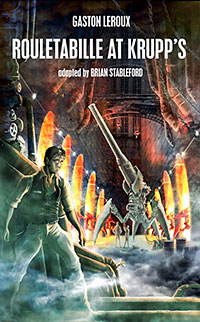 The next couple of novels have him dealing with new mysteries. First he is summoned by the Russian Czar to solve a mystery in the Russian court (Rouletabille and the Czar). Next he deals with the mad Turk warlord Gaulow, Lord of the Black Castle (Routletabille at War).
The next couple of novels have him dealing with new mysteries. First he is summoned by the Russian Czar to solve a mystery in the Russian court (Rouletabille and the Czar). Next he deals with the mad Turk warlord Gaulow, Lord of the Black Castle (Routletabille at War).
The fifth novel goes in a different direction. Written during WWI, we find Rouletabille recruited by the French government to be a secret agent, given the mission to go behind enemy lines and putting an end to a sinister and dangerous super weapon. Routletabille at Krupp‘s is one of the first examples of the secret agent genre of works. Hence why Black Coat has also done this one.
Unlike the first, its written third-person. No narrator. And the super weapon is a bit, well, preposterous. It is basically a guided nuclear missile. The size of the Titanic! That also launches many smaller missiles to increase the size of the impact. A French scientist proposes this, wanting to use it against Berlin, but is rejected. He turns to England, which has him make a smaller prototype more as a weapon to end war than a “weapon of mass destruction.”
But the scientist, his daughter, and her fiance (who is also the scientist’s assistant) are kidnapped and Rouletabille must break them out. A recent escapee is able to provide some information, but after a meeting with higher-ups, he is assassinated! Rouletabille recruits two men who assisted him in the prior novel. His scheme is to have one of the men and himself be captured and sent to the Krupp factory, while the other man works from the outside. Hopefully they will be able to break them out before they finish the weapon. They do, but there are many twists and turns before the end.
The weapon is built, just that the Germans don’t have the codes to launch it (as if they can’t figure this out over time). Yeah, there are some problems in this novel. There is a nice afterward which points out these issues. Despite this, the story was interesting and suspenseful.
In the final two novels from Leroux, Rouletabille is almost framed for his wife’s murder (The Crime of Rouletabille). And finally, he goes up against the deadly Madame de Mayrens (aka “The Octopus”) and helps recover a sacred book of the gypsies (Rouletabille and the Gypsies).
He has also appeared in a few new stories in the Tales of the Shadowmen series.
Rouletabille is very popular in France, and has appeared in various other medium, including movies (two done recently adapt the first two novels), television (four mini-series in the mid 1960s), radio, and comics (a series, plus graphic albums ala Tintin).
While I would like to see some of the other novels translated, both of these works are pretty good. However, I understand that most of the rest are not that good.

